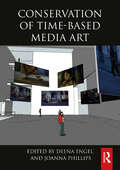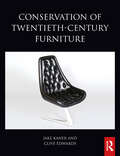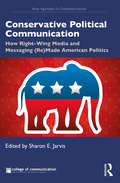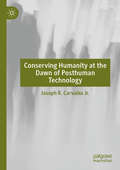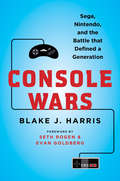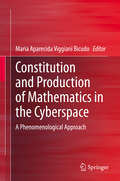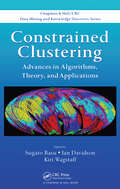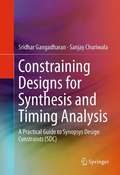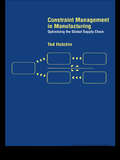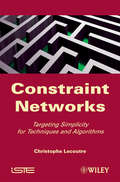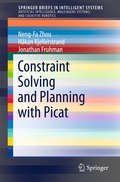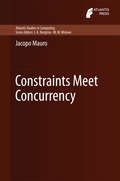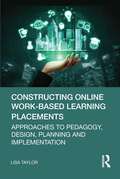- Table View
- List View
Conservation of Photographs: Significance, Use and Care (Routledge Series in Conservation and Museology)
by Heather Brown Luisa CasellaConservation of Photographs: Significance, Use and Care provides a comprehensive and inclusive overview of theory, research, and practice in the conservation of photograph collections, from the analogue to the digital era.Including insights from nearly 100 leading international professionals, this book is a tribute to the synergistic advancements in photograph conservation in recent decades. Connecting material, imaging, computational and natural sciences, aesthetics, ethics and philosophy, history, art history, art and cultural context studies, these engaging writings contextualize our photographic heritage and its long-term preservation – past, present, and future. This book explores the philosophical underpinnings and evolution of the field, before moving on to detail innovative methodologies for assessing photographic heritage. The inclusion of material on characterization, imaging and authentication studies, conservation practice, innovation and ethical constraints, as well as on current approaches to effective collections management and preventive care, ensures that this volume is an invaluable resource and important practical reference.Conservation of Photographs: Significance, Use and Care will spark a collective drive towards a more complete understanding and preservation of the world’s photographic legacy. As such, the volume is useful for scholars, students, and practitioners working in the fields of photography, conservation, art, art history, history, and cultural heritage.
Conservation of Time-Based Media Art (Routledge Series in Conservation and Museology)
by Deena Engel Joanna PhillipsConservation of Time-based Media Art is the first book to take stock of the current practices and conceptual frameworks that define the emerging field of time-based media conservation, which focuses on contemporary artworks that contain video, audio, film, slides or software components. Written and compiled by a diverse group of time-based media practitioners around the world, including conservators, curators, registrars and technicians among others, this volume offers a comprehensive survey of specialized practices that have developed around the collection, preservation and display of time-based media art. Divided into 23 chapters with contributions from 36 authors and 85 additional voices, the narrative of this book provides both an overview and detailed guidance on critical topics, including the acquisition, examination, documentation and installation of time-based media art; cross-medium and medium-specific treatment approaches and methods; the registration, storage, and management of digital and physical artwork components; collection surveys and project advocacy; lab infrastructures, staffing and the institutional implementation of time-based media conservation. Conservation of Time-based Media Art serves as a critical resource for conservation students and for a diverse professional audience who engage with time-based media art, including conservation practitioners and other collection caretakers, curators, art historians, collectors, gallerists, artists, scholars and academics.
Conservation of Twentieth-Century Furniture (Routledge Series in Conservation and Museology)
by Clive Edwards Jake KanerConservation of Twentieth-Century Furniture provides comprehensive and accessible coverage of the materials and techniques that are encountered in furniture of this century.After putting the design, manufacture and conservation of twentieth-century furniture into context, the volume then offers an A-Z of materials organised into 12 chapters. Within each chapter a wide variety of material types are discussed, observed, analysed and contextualised, and a list of further sources is provided. The furniture discussed in this book ranges from designer craftsman, individually made pieces, to factory-produced batch items, and includes cabinet work, decoration, surface finishes and upholstery, observing the traditional repertoire of materials, as well as innovative materials and processes introduced over the course of this century. Following the material chapters, the book also includes brief case studies that illustrate some examples of twentieth-century furniture conservation, with a focus on metal, plastic and wood.Conservation of Twentieth-Century Furniture is the primary resource for those working on the manufacture, history and care of furniture of this period, including conservators, curators, dealers and collectors.
Conservative Political Communication: How Right-Wing Media and Messaging (Re)Made American Politics (New Agendas in Communication Series)
by Sharon E. JarvisConservative Political Communication examines the evolution of appeals, media, and tactics in right-wing media and political communication, tracking trends and shifts from the early days of contemporary conservatism in the 1950s to the Trump administration. The chapters in this edited volume feature the work of senior and junior scholars from the fields of communication, journalism, and political science employing content analytic, experimental, survey, historical, and rhetorical research methodologies. Analyses of the rise of the 24-hour news cycle, the range of partisan news sources, and the role of social media algorithms in political campaigns yield insights for our media and information ecosystems. A key theme across these chapters is how right-wing channels and communications help and hinder partisan fragmentation, a condition whereby novice elected officials create personal conservative brands, appeal to the base through partisan media, and complicate senior leadership’s ability to engage in bargaining, compromise, and deal-making. This volume interrogates conservative media and messaging to track where these processes came from, how they functioned in the 2016 U.S. presidential campaign, and where they may be going in the future. This book will interest scholars and upper-level students of political communication, media and politics, and political science, as well as readers invested in today’s political media landscape in the United States.
Conserving Humanity at the Dawn of Posthuman Technology
by Joseph R. Carvalko Jr.This volume examines the latest scientific and technological developments likely to shape our post-human future. Using a multidisciplinary approach, the author argues that we stand at the precipice of an evolutionary change caused by genetic engineering and anatomically embedded digital and informational technologies. The author delves into current scientific initiatives that will lead to the emergence of super smart individuals with unique creative capacities. He draws on technology, psychology and philosophy to consider humans-as-they-are relative to autonomy, creativity, and their place in a future shared with ‘post humans.’ The author discusses the current state of bioethics and technology law, both which policymakers, beset by a torrent of revolutionary advances in bioengineering, are attempting to steer. Significantly, Carvalko addresses why we must both preserve the narratives that brought us to this moment and continue to express our humanity through, music, art, and literature, to ensure that, as a uniquely creative species, we don’t simply vanish in the ether of an evolution brought about by our own technology.
Considerations on the AI Endgame: Ethics, Risks and Computational Frameworks (Chapman & Hall/CRC Artificial Intelligence and Robotics Series)
by Soenke Ziesche Roman V. YampolskiyThis seminal volume offers an interdisciplinary exploration into the rapidly evolving field of artificial intelligence and its societal implications. Written by leading scholars Soenke Ziesche and Roman V. Yampolskiy, the book delves into a multitude of topics that address the rapid technological advancements in AI and the ethical dilemmas that arise as a result.The topics explored range from an in-depth look at AI welfare science and policy frameworks to the mathematical underpinnings of machine intelligence. These subjects include discussions on preserving our personal identity in technological contexts as well as on the question of AI identity, innovative proposals towards the critical AI value alignment problem and a call to merge Western and non-Western approaches towards universal AI ethics. The work also introduces unconventional yet crucial angles, such as the concept of "ikigai" in AI ethics and a pioneering attempt to map a potential AI-driven ikigai universe as well as the role of design formalisation, or "Designometry," in the creation of artefacts.By offering a balanced mix of theoretical and applied insights, the book serves as an invaluable resource for researchers, policymakers and anyone interested in the future of AI and the extent of its impact on society.
Considering Computer Contracting?: The Computer Weekly Guide To Becoming A Freelance Computer Professional (Computer Weekly Professional Ser.)
by Michael PowellConsidering computer contracting?If you are, then read this book. It explores the many aspects of the computer contracting world and gives sound practical advice to both the newcomer and the experienced contractor. It will also be invaluable if you are an employer wrestling with the perennial problem of finding staff in this highly competitive marketplace.Let this book show you how to break loose from being an employee to working freelance. The author, a freelancer himself, considers what it takes to become a contract worker and gives you invaluable information throughout to help you get started in the world of computer contracting. This book looks at:* why contract workers are used at all - what kind of companies actually employ contractors, and why?* how you make the transition from full-time working - what does it actually take temperamentally to be a successful contractor?* how you start - what does forming your own company involve, and why is it even necessary?* how you go about finding a contract, and negotiating the right rate.* what agencies do for you - and how can you find who are the best?* the financial differences between being a full-time employee and a contractor - how do you manage your affairs?* how you keep your experience up to date when you do not have a regular employer to help train you.* what sort of opportunities are available, and what sort of rates of pay you can expect.* your possible career progressions after contracting.The contracting scene is ever changing. In this wide-ranging book, the current outlook for contract staff is analysed as well as the trends in the computer industry which are driving these changes. Some doors are opening whilst other close - let this book be your guide.If you have marketable skills, the right attitude and would like to be your own boss, there could not be a better time to consider computer contracting.
Console Wars: Sega, Nintendo, and the Battle that Defined a Generation
by Blake J. HarrisNow a documentary on CBS All Access. Following the success of The Accidental Billionaires and Moneyball comes Console Wars—a mesmerizing, behind-the-scenes business thriller that chronicles how Sega, a small, scrappy gaming company led by an unlikely visionary and a team of rebels, took on the juggernaut Nintendo and revolutionized the video game industry. In 1990, Nintendo had a virtual monopoly on the video game industry. Sega, on the other hand, was just a faltering arcade company with big aspirations and even bigger personalities. But that would all change with the arrival of Tom Kalinske, a man who knew nothing about videogames and everything about fighting uphill battles. His unconventional tactics, combined with the blood, sweat and bold ideas of his renegade employees, transformed Sega and eventually led to a ruthless David-and-Goliath showdown with rival Nintendo.The battle was vicious, relentless, and highly profitable, eventually sparking a global corporate war that would be fought on several fronts: from living rooms and schoolyards to boardrooms and Congress. It was a once-in-a-lifetime, no-holds-barred conflict that pitted brother against brother, kid against adult, Sonic against Mario, and the US against Japan.Based on over two hundred interviews with former Sega and Nintendo employees, Console Wars is the underdog tale of how Kalinske miraculously turned an industry punchline into a market leader. It’s the story of how a humble family man, with an extraordinary imagination and a gift for turning problems into competitive advantages, inspired a team of underdogs to slay a giant and, as a result, birth a $60 billion dollar industry.A best book of the year: NPR, Slate, Publishers Weekly, Goodreads
Constitution and Production of Mathematics in the Cyberspace: A Phenomenological Approach
by Maria Aparecida Viggiani BicudoThis book brings together various studies that assume phenomenology to analyze how mathematics education is affected by the experience of being in the cyberspace. The authors of the chapters included in this contributed volume work with the theoretical framework developed by authors such as Edmund Husserl, Martin Heidegger and Maurice Merleau-Ponty to investigate how mathematics is produced and comprehended in a new way of being in the world, with digital technologies. The aim of this book is not to explain the tools used and how one works with them in the cyberspace, aiming at better teaching and learning mathematics. Its purpose is to present philosophical investigations that contribute to the understanding of the complexity of the world in which we are being researchers and mathematics teachers. By doing so, Constitution and Production of Mathematics in the Cyberspace – A Phenomenological Approach will help researchers and mathematics teachers understand their role in a world in which the experience of teaching and learning mathematics is being radically changed by new technologies and new ways of being in this world.
Constrained Clustering: Advances in Algorithms, Theory, and Applications (Chapman & Hall/CRC Data Mining and Knowledge Discovery Series)
by Ian MuehlenhausThis volume encompasses many new types of constraints and clustering methods as well as delivers thorough coverage of the capabilities and limitations of constrained clustering. With contributions from industrial researchers and leading academic experts who pioneered the field, it provides a well-balanced combination of theoretical advances, key algorithmic development, and novel applications. The book presents various types of constraints for clustering and describes useful variations of the standard problem of clustering under constraints. It also demonstrates the application of clustering with constraints to relational, bibliographic, and video data.
Constraining Designs for Synthesis and Timing Analysis: A Practical Guide to Synopsys Design Constraints (SDC)
by Sanjay Churiwala Sridhar GangadharanThis book serves as a hands-on guide to timing constraints in integrated circuit design. Readers will learn to maximize performance of their IC designs, by specifying timing requirements correctly. Coverage includes key aspects of the design flow impacted by timing constraints, including synthesis, static timing analysis and placement and routing. Concepts needed for specifying timing requirements are explained in detail and then applied to specific stages in the design flow, all within the context of Synopsys Design Constraints (SDC), the industry-leading format for specifying constraints.
Constraint Handling in Cohort Intelligence Algorithm (Advances in Metaheuristics)
by Anand J. Kulkarni Ishaan R. KaleMechanical Engineering domain problems are generally complex, consisting of different design variables and constraints. These problems may not be solved using gradient-based optimization techniques. The stochastic nature-inspired optimization techniques have been proposed in this book to efficiently handle the complex problems. The nature-inspired algorithms are classified as bio-inspired, swarm, and physics/chemical-based algorithms. Socio-inspired is one of the subdomains of bio-inspired algorithms, and Cohort Intelligence (CI) models the social tendencies of learning candidates with an inherent goal to achieve the best possible position. In this book, CI is investigated by solving ten discrete variable truss structural problems, eleven mixed variable design engineering problems, seventeen linear and nonlinear constrained test problems and two real-world applications from manufacturing domain. Static Penalty Function (SPF) is also adopted to handle the linear and nonlinear constraints, and limitations in CI and SPF approaches are examined. Constraint Handling in Cohort Intelligence Algorithm is a valuable reference to practitioners working in the industry as well as to students and researchers in the area of optimization methods.
Constraint Handling in Metaheuristics and Applications
by Yong Wang Amir H. Gandomi Ganesh Krishnasamy Anand J. Kulkarni Efrén Mezura-MontesThis book aims to discuss the core and underlying principles and analysis of the different constraint handling approaches. The main emphasis of the book is on providing an enriched literature on mathematical modelling of the test as well as real-world problems with constraints, and further development of generalized constraint handling techniques. These techniques may be incorporated in suitable metaheuristics providing a solid optimized solution to the problems and applications being addressed. The book comprises original contributions with an aim to develop and discuss generalized constraint handling approaches/techniques for the metaheuristics and/or the applications being addressed. A variety of novel as well as modified and hybridized techniques have been discussed in the book. The conceptual as well as the mathematical level in all the chapters is well within the grasp of the scientists as well as the undergraduate and graduate students from the engineering and computer science streams. The reader is encouraged to have basic knowledge of probability and mathematical analysis and optimization. The book also provides critical review of the contemporary constraint handling approaches. The contributions of the book may further help to explore new avenues leading towards multidisciplinary research discussions. This book is a complete reference for engineers, scientists, and students studying/working in the optimization, artificial intelligence (AI), or computational intelligence arena.
Constraint Management in Manufacturing: Optimising the Supply Chain
by Ted HutchinFocusing on making money out of the supply chain, this book describes how to successfully manage manufacturing companies in today's global context. The text explores how constraint management, with roots in the Theory of Constraints, produces wealth through the development of manufacturers' strengths. Constraint Management in Manufacturing:
Constraint Networks: Targeting Simplicity for Techniques and Algorithms (Wiley-iste Ser.)
by Christophe LecoutreA major challenge in constraint programming is to develop efficient generic approaches to solve instances of the constraint satisfaction problem (CSP). With this aim in mind, this book provides an accessible synthesis of the author's research and work in this area, divided into four main topics: representation, inference, search, and learning. The results obtained and reproduced in this book have a wide applicability, regardless of the nature of the problem or the constraints involved, making it an extremely user-friendly resource for those involved in this field.
Constraint Programming and Decision Making: Theory and Applications (Studies in Systems, Decision and Control #100)
by Vladik Kreinovich Martine CeberioThis book describes new algorithms and ideas for making effective decisions under constraints, including applications in control engineering, manufacturing (how to optimally determine the production level), econometrics (how to better predict stock market behavior), and environmental science and geosciences (how to combine data of different types). It also describes general algorithms and ideas that can be used in other application areas. The book presents extended versions of selected papers from the annual International Workshops on Constraint Programming and Decision Making (CoProd'XX) from 2013 to 2016. These workshops, held in the US (El Paso, Texas) and in Europe (W#65533;rzburg, Germany, and Uppsala, Sweden), have attracted researchers and practitioners from all over the world. It is of interest to practitioners who benefit from the new techniques, to researchers who want to extend the ideas from these papers to new application areas and/or further improve the corresponding algorithms, and to graduate students who want to learn more - in short, to anyone who wants to make more effective decisions under constraints.
Constraint Solving and Planning with Picat (SpringerBriefs in Intelligent Systems #0)
by Neng-Fa Zhou Håkan Kjellerstrand Jonathan FruhmanThis book introduces a new logic-based multi-paradigm programming language that integrates logic programming, functional programming, dynamic programming with tabling, and scripting, for use in solving combinatorial search problems, including CP, SAT, and MIP (mixed integer programming) based solver modules, and a module for planning that is implemented using tabling. The book is useful for undergraduate and graduate students, researchers, and practitioners.
Constraint-based Local Search
by Pascal Van Hentenryck Laurent MichelThe ubiquity of combinatorial optimization problems in our society is illustrated by the novel application areas for optimization technology, which range from supply chain management to sports tournament scheduling. Over the last two decades, constraint programming has emerged as a fundamental methodology to solve a variety of combinatorial problems, and rich constraint programming languages have been developed for expressing and combining constraints and specifying search procedures at a high level of abstraction. Local search approaches to combinatorial optimization are able to isolate optimal or near-optimal solutions within reasonable time constraints.This book introduces a method for solving combinatorial optimization problems that combines constraint programming and local search, using constraints to describe and control local search, and a programming language, COMET, that supports both modeling and search abstractions in the spirit of constraint programming.After an overview of local search including neighborhoods, heuristics, and metaheuristics, the book presents the architecture and modeling and search components of constraint-based local search and describes how constraint-based local search is supported in COMET. The book describes a variety of applications, arranged by meta-heuristics. It presents scheduling applications, along with the background necessary to understand these challenging problems. The book also includes a number of satisfiability problems, illustrating the ability of constraint-based local search approaches to cope with both satisfiability and optimization problems in a uniform fashion.
Constraints Meet Concurrency (Atlantis Studies in Computing #5)
by Jacopo MauroThis book describes the benefits that emerge when the fields of constraint programming and concurrency meet. On the one hand, constraints can be used in concurrency theory to increase the conciseness and the expressive power of concurrent languages from a pragmatic point of view. On the other hand, problems modeled by using constraints can be solved faster and more efficiently using a concurrent system. Both directions are explored providing two separate lines of development. Firstly the expressive power of a concurrent language is studied, namely Constraint Handling Rules, that supports constraints as a primitive construct. The features of this language which make it Turing powerful are shown. Then a framework is proposed to solve constraint problems that is intended to be deployed on a concurrent system. For the development of this framework the concurrent language Jolie following the Service Oriented paradigm is used. Based on this experience, an extension to Service Oriented Languages is also proposed in order to overcome some of their limitations and to improve the development of concurrent applications.
Construct 2 Game Development by Example
by John BuraThis book uses practical examples to teach readers, and imparts the key skills and techniques of working in Construct 2 through building complete game projects. This book is for complete beginners who have always wanted to learn how to make games and have never tried. It is the perfect introduction to game development, design, and production.
Construct Game Development Beginner’s Guide
by Daven BigelowThis is a beginner's guide with plenty of screenshots and step-by-step instructions. Through three sample games, the reader will learn about practically creating games with Construct. If you have thought of making a game of your own, this book is for you. All you need to know is that you can and how to operate a computer!
Construct, Merge, Solve & Adapt: A Hybrid Metaheuristic for Combinatorial Optimization (Computational Intelligence Methods and Applications)
by Christian BlumThis book describes a general hybrid metaheuristic for combinatorial optimization labeled Construct, Merge, Solve & Adapt (CMSA). The general idea of standard CMSA is the following one. At each iteration, a number of valid solutions to the tackled problem instance are generated in a probabilistic way. Hereby, each of these solutions is composed of a set of solution components. The components found in the generated solutions are then added to an initially empty sub-instance. Next, an exact solver is applied in order to compute the best solution of the sub-instance, which is then used to update the sub-instance provided as input for the next iteration. In this way, the power of exact solvers can be exploited for solving problem instances much too large for a standalone application of the solver. Important research lines on CMSA from recent years are covered in this book. After an introductory chapter about standard CMSA, subsequent chapters cover a self-adaptive CMSA variant as well as a variant equipped with a learning component for improving the quality of the generated solutions over time. Furthermore, on outlining the advantages of using set-covering-based integer linear programming models for sub-instance solving, the author shows how to apply CMSA to problems naturally modelled by non-binary integer linear programming models. The book concludes with a chapter on topics such as the development of a problem-agnostic CMSA and the relation between large neighborhood search and CMSA. Combinatorial optimization problems used in the book as test cases include the minimum dominating set problem, the variable-sized bin packing problem, and an electric vehicle routing problem. The book will be valuable and is intended for researchers, professionals and graduate students working in a wide range of fields, such as combinatorial optimization, algorithmics, metaheuristics, mathematical modeling, evolutionary computing, operations research, artificial intelligence, or statistics.
Constructed Truths: Truth and Knowledge in a Post-truth World
by Thomas ZoglauerIn a world in which more and more fake news is being spread, it is becoming increasingly difficult to distinguish truth from lies, knowledge from opinion. Disinformation campaigns are not only perceived as a political problem, but the fake news debate is also about fundamental philosophical questions: What is truth? How can we recognize it? Is there such a thing as objective facts or is everything socially constructed? This book explains how echo chambers and alternative worldviews emerge, it blames post-factual thinking for the current truth crisis, and it shows how we can escape the threat of truth relativism.
Constructing Accessible Web Sites
by Paul Bohman Jim Thatcher Cynthia Waddell Shawn Henry Sarah Swierenga Mark Urban Michael BurksA guide to the whys and hows of creating web accessible websites.
Constructing Online Work-Based Learning Placements: Approaches to Pedagogy, Design, Planning and Implementation
by Lisa TaylorConstructing Online Work-Based Learning Placements offers a step-by-step approach to understanding and applying the principles of design and delivery in online work-based learning (WBL) placements for students. A crucial component of employability strategies for higher education students, WBL placements are increasingly in need of adaptation to respond to today’s rapidly expanding online work environments. This evidence-based book explores the emergent properties and additional value that online WBL placements provide to student learning and employability prospects, focusing on effective pedagogy, design, planning and implementation. The book also presents the Peer Enhanced e-Placement (PEEP), a pioneering, positively evaluated and award-winning online WBL placement model that is underpinned by pedagogical research and theory. The PEEP has been adapted and adopted by numerous higher education teams organising online WBL placements, and the case example included in these pages will guide readers through their own implementation and collaborations.

